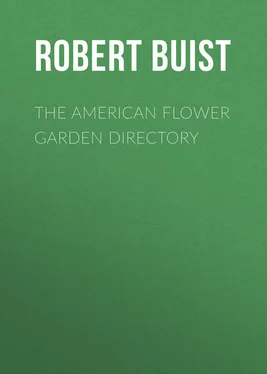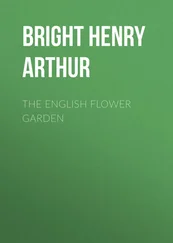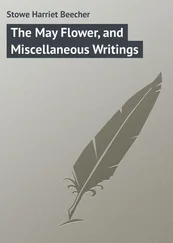Robert Buist - The American Flower Garden Directory
Здесь есть возможность читать онлайн «Robert Buist - The American Flower Garden Directory» — ознакомительный отрывок электронной книги совершенно бесплатно, а после прочтения отрывка купить полную версию. В некоторых случаях можно слушать аудио, скачать через торрент в формате fb2 и присутствует краткое содержание. Жанр: foreign_antique, foreign_prose, на английском языке. Описание произведения, (предисловие) а так же отзывы посетителей доступны на портале библиотеки ЛибКат.
- Название:The American Flower Garden Directory
- Автор:
- Жанр:
- Год:неизвестен
- ISBN:нет данных
- Рейтинг книги:5 / 5. Голосов: 1
-
Избранное:Добавить в избранное
- Отзывы:
-
Ваша оценка:
- 100
- 1
- 2
- 3
- 4
- 5
The American Flower Garden Directory: краткое содержание, описание и аннотация
Предлагаем к чтению аннотацию, описание, краткое содержание или предисловие (зависит от того, что написал сам автор книги «The American Flower Garden Directory»). Если вы не нашли необходимую информацию о книге — напишите в комментариях, мы постараемся отыскать её.
The American Flower Garden Directory — читать онлайн ознакомительный отрывок
Ниже представлен текст книги, разбитый по страницам. Система сохранения места последней прочитанной страницы, позволяет с удобством читать онлайн бесплатно книгу «The American Flower Garden Directory», без необходимости каждый раз заново искать на чём Вы остановились. Поставьте закладку, и сможете в любой момент перейти на страницу, на которой закончили чтение.
Интервал:
Закладка:
A hand engine is certainly the best. Milne's patent hand engine surpasses any that we have used. Nevertheless a hand syringe is very effectual. Some of these engines are powerful, throwing the water above forty feet. Read's patent of London is excellent. At the store of D. & C. Landreth, Phila., there is a very good kind, which answers admirably in small houses. Tie up neatly with stakes, and threads of Russia mat, all the straggling growing plants; let the stakes be proportionate to the plants, and never longer, except they are climbing sorts. Do not tie the branches in bundles, but singly and neatly, imitating nature as much as possible. If any of the plants are affected with the Cocus insect, let them be cleaned according to the plan already mentioned, taking particular care also in washing the stakes to which they had been previously tied, and burning all the old tyings, which contain the larvæ of the insect in many instances, especially of Cocus hesperidus . It is premised, when any of these things are done, that they will be well done, and not half doing, and always doing. Cleanliness, in every respect, promotes a pure air, which is congenial to vegetation, and will, with other attention, always ensure a healthful and vigorous appearance in the house.
Green-House
JANUARY
This compartment requires particular attention, in order to preserve the plants in good health, and carry them through this precarious season of the year. A little air must be admitted at all convenient times. An hour or two at mid-day will be of the utmost importance in drying up damp, and clearing off stagnated air, which is a harbour for every corruption. The top sashes being let down, or turned a few inches, in mild days (that is, when it is not high and cutting winds) from ten or eleven o'clock to two or three, according to the intensity of the frost, will renovate the interior air of the house, and harden the plants. When the weather will permit, let the front sashes be opened about one inch or more. An assiduous, experienced hand will never omit an opportunity.
With regard to fire heat, the temperature must be regulated to suit the nature of the plants in a general sense; so let the mercury, or spirits of wine, of Fahrenheit's thermometer, be from 34° to 43°; if it begins to fall, give a little fire heat. No doubt we have seen the thermometer much lower in the Green-house, than the above, even as low as 24°, without any immediate injury; but it was in an extensive collection, where the most hardy of the plants were selected into one house. Many boast how little fire they give their Green-house, and how cold it is kept, not observing the miserable state of their plants, – inexperience causing them to think, that the least fire heat will make them grow, and would rather look on naked stems than healthy plants. The above temperature will not, in exotics, cause premature vegetation, but will cause the plants to retain the foliage requisite to vegetative nature. A high temperature is not necessary for the generality of Green-house plants; on the contrary, it might very much injure them.
OF WATERING
In this month very little is requisite, and must be given with great caution. Few plants will require much, and some hardly any; but all must be attended to, and have their wants supplied. Some will need it twice, some once a week, and some in two weeks, according to their shrubby and woody nature. Herbaceous and deciduous plants will seldom need water. Perhaps, from the throwing of the foliage, to the commencement of vegetation, three or four times will be sufficient. Particular attention should be paid to the state of health and of growth, in which the plants respectively are, in the application of water; otherwise much mischief may be done, and many entirely ruined.
Green-house plants, being now in an absolutely inactive state, require little more water than merely to keep the earth about their roots from becoming perfectly dry, by occasionally applying a very small quantity at the root; and, if done with a watering pot, as described under this head in the Hot-house of this month, very little will be spilt in the house to increase dampness, which, if it does appear, by any of the leaves of the plants becoming musty, they must be instantly picked off; and, if it increases, give a little fire and air. Succulent plants will not need any water during this month, unless omitted in December.
CAMELLIA JAPONICA
This magnificent and attractive flower, with all its splendid varieties, will, about this time, begin to open its beautiful flowers. But for this admired genus of plants, our Green-houses, at this season, would be void of allurement. It is, in this country, subject to mildew and red spider, and more especially in the city, which appears to be from the nature of the air. The effects of mildew on these plants, if not prevented, would prove fatal; as, from appearance, many have died by it in our city. If it has reached a great extent, the leaves are brownish, having the appearance of being decayed, or scorched with the sun. In taking hold of the leaf, it feels soft, and altogether seems to have lost its nutritive substance; and, when the young foliage expands, it becomes covered with dark brown spots, and finally very much disfigured; and, when in this state, it is attacked by red spider, and, ultimately, death ensues.
If any of the plants are affected as above described, take a sponge, and wash every leaf minutely with soft water, and syringe them with water three or four times a week, which will clean them. All the young foliage will be healthy, and that which has been affected will fall off. However, prevention is better than cure; and if the Camellias are properly syringed every evening during summer, and once or twice a week during winter, they will never be subject to the ravages of mildew or of red spider.
Tie up any of the flowers that are expanded to stakes, in case of accident; and, in syringing, observe not to let any water fall on the flowers, as it causes premature decay, and change of colour.
The mildew first appears like small particles of very fine flour, around the under edge of the leaves, and visible to the naked eye; so that, syringing, sponging, &c. under the leaf is most requisite; but, as the mildew extends, both sides of the leaves are covered with these white particles.
OF ORANGES, LEMONS, &c
As there will perhaps be more leisure in the Green-house this month than in any other during the winter, it is presumed that there will not be a moment lost. If any of the trees are infested with insects, these, being now in their inactive state, may be more easily destroyed than at any other time. It is the brown scaly insect that generally infests them. For treatment, see Hothouse, January . The plant, or tree, after being washed, before it becomes dry, will require to be syringed with water, otherwise the dust will adhere to the glutinous particles of the soap. Set the plant in an airy situation to dry, in case of damp. There are several others subject to this insect, such as Myrtles , Oleas , Oleanders , &c. which treat in the same manner. Be careful that these trees are not over watered; if the soil is moist, it is sufficient.
OF CAPE BULBS, &c
If there are any out of the ground, it is time that the whole were potted, such as Lachenàlia , Wachendórfia , Eùcomis , Ixia , Gladìolus , with several others. Keep them in the shade until they begin to grow; then put them on shelves near the light. Those that are growing must be kept in front of the house, to prevent them being weak. Wachendórfia has a beautiful large red tuber root; and, as the new root descends, give it a pot about six or seven inches.
Читать дальшеИнтервал:
Закладка:
Похожие книги на «The American Flower Garden Directory»
Представляем Вашему вниманию похожие книги на «The American Flower Garden Directory» списком для выбора. Мы отобрали схожую по названию и смыслу литературу в надежде предоставить читателям больше вариантов отыскать новые, интересные, ещё непрочитанные произведения.
Обсуждение, отзывы о книге «The American Flower Garden Directory» и просто собственные мнения читателей. Оставьте ваши комментарии, напишите, что Вы думаете о произведении, его смысле или главных героях. Укажите что конкретно понравилось, а что нет, и почему Вы так считаете.












